Physical Address
304 North Cardinal St.
Dorchester Center, MA 02124
Facial paralysis (FP) can be devastating, both emotionally and functionally. A lack of facial expression removes the visible thumbprint of personality in day-to-day interactions. The inability to smile or simply make a symmetric facial expression takes an emotional toll on a patient’s self-esteem. Although other aspects of the facial nerve function, including oral competence and nasal airway patency, may be affected by FP, care of the eye is paramount. Although an asymmetric smile, nasal alar collapse, or oral incompetence may develop and be problematic, these losses are not as functionally detrimental, acutely or chronically, when compared with the inability to close or protect the eye properly.
The loss of orbicularis oculi function (protraction of the eyelid) leads to unopposed actions by the levator palpebrae superioris, which opens the upper eyelid, leaving the inferior sclera and cornea exposed. Similarly, the capsulopalpebral fascia of the lower eyelid, if not actively contracted by the orbicularis, can passively retract and cause lower lid lagophthalmos and ectropion. Further, the simple mechanical weight of a paralyzed midface can lead to lower eyelid malposition. Eyelid closure deficits result in the increased exposure of the corneal epithelium, which can lead to desiccation, irritation, and potential vision loss. Patients may lack a Bell phenomenon, also called the palpebral oculogyric reflex, in which the globe is involuntarily rolled superiorly and laterally with an attempt to close the lid. This reflex may be amplified during times of FP as an oculoprotective mechanism ( Fig. 56.1 ).
Dysfunctional tearing may also occur. If the facial nerve lesion is proximal to the departure of the greater superficial petrosal nerve, which carries parasympathetic signals destined for the lacrimal gland, then lacrimation may decrease because of altered parasympathetic innervation to the lacrimal gland. The decreased blink rate causes decreased tear distribution by the upper lid. The inferior lacrimal punctum may be lateralized and everted. The loss of a lacrimal pump mechanism leads to dysfunctional tearing, manifested as epiphora ( Fig. 56.2 ). This is often described by the patient as a the “watery dry eye” or the “drippy dry eye.” Given the lack of proper tear distribution secondary to the loss of a thorough blink, the eyes often feel dry, yet watery related to a lack of the pumping mechanism of the orbicularis, the eversion of the lower lid which creates a tear reservoir, and anterior displacement and lateralization of the medial puncta prohibiting even passive tear drainage. Additional morbidity can be caused by brow ptosis with secondary dermatochalasis, which may lead to obstruction of the superior visual field and facial asymmetry.
Special considerations must be taken for the patient with FP who also has lost the function of the ophthalmic division of the trigeminal nerve (V1), whether due to CPA pathology, trauma, or iatrogenic injuries following surgery. While exposure keratopathy following FP can be a serious problem, neurotropic keratopathy (NK) due to the insensate cornea can be devastating, even in patients with normal facial nerve function and eyelid closure.
The cornea is the transparent anterior portion of the eye responsible for two-thirds of the refractive power of the eye, with the remainder accomplished via accommodation by the lens. The cornea lacks blood vessels and obtains its nutrients via tear diffusion. It is innervated by the long ciliary nerve branch of the ophthalmic division of the trigeminal nerve (V1), which initiates the blink reflex (motor arc via the facial nerve), stimulates tear production (autonomic arc via the GSPN), and maintains the health of the corneal epithelium by stimulating the secretion of trophic neuromodulators. Corneal sensation is critical in maintaining the epithelial integrity and limbal stem cell function, which function as a barrier between the cornea and conjunctival epithelial cells and prevent epithelial migration onto the corneal surface. , In addition, the poor healing secondary to corneal sensory denervation favors the formation of non-healing epithelial defects that ulcerate and perforate if not appropriately treated.
Because of the loss of multiple protective mechanisms and the severity of the potential complications, immediate aggressive ocular management must be pursued once a facial nerve paralysis has been discovered. The treatment goals include protection of the eye as well as restoration of symmetric appearance at rest and, if possible, some voluntary control of muscle contraction.
Before the initiation of either medical or surgical treatment, the initial evaluation usually begins in clinic in the days or weeks following the onset of FP. A complete history and physical examination accompanied by photographic documentation of the patient’s current appearance are essential. The timeline of onset, duration, cause, severity, and prognosis of facial nerve paralysis are integral in treatment planning. A full cranial nerve examination, with particular focus on the function of the ipsilateral trigeminal, hypoglossal, and contralateral facial nerves, should be assessed carefully in case a nerve-to-nerve transposition is being considered. The precise function of the facial nerve should be determined at each clinical assessment for each facial zone. The House-Brackmann system for grading facial nerve function is the most commonly employed tool for communicating the overall facial nerve function. The complete analysis of the facial nerve function includes a physical examination, photography, and other testing. Electromyography (EMG), the nerve excitability test (NET), and electroneurography (ENOG) are also important tools in determining facial nerve recovery prognosis.
Although the paralysis may involve all the branches of the facial nerve, it is necessary to evaluate the entire face in separate zones. Specific attention should be given to the forehead, periocular area, midface, perioral region, and the neck. In regard to ocular reanimation, one must acknowledge the forehead, brows, lids, and puncta separately. The presence of synkinesis or partial FP must be noted.
The presence or absence of the Bell phenomenon should be observed. We know that patients with a loss of the Bell phenomenon and/or decreased corneal sensation are at risk for poorer outcomes for the eye, including higher rates of corneal abrasions and ocular infections. A full ophthalmologic examination should be done including the evaluation of the cornea with fluorescein.
The presence or absence of corneal sensation is imperative to note. The eye in patients with neurotrophic keratitis has the same erythema, impaired vision, and photophobia seen in patients with exposure keratitis; however, they do not have any pain. Therefore, clinicians must have a high sense of suspicion to prevent delayed diagnosis. In these patients, a full ophthalmological exam is indicated, including visual acuity, slit lamp, and fluorescein and tear film testing. Corneal esthesiometry using a Cochet-Bonnet esthesiometer should be done centrally and in all four quadrants, which uses a 0.12-mm nylon monofilament adjusted to varying lengths to apply the variable intensities of mechanical pressure (60 mm is normal, 0 mm is completely insensate) ( Fig. 56.3 ). NK is broken down into three stages using the Mackie classification. Stage one lesions have early corneal abnormalities with fluorescein staining with superficial hypervascularization. Stage two lesions have a large epithelial defect with smooth, rolled edges. Stage three lesions show ulceration with stromal melting and possible perforation. ,
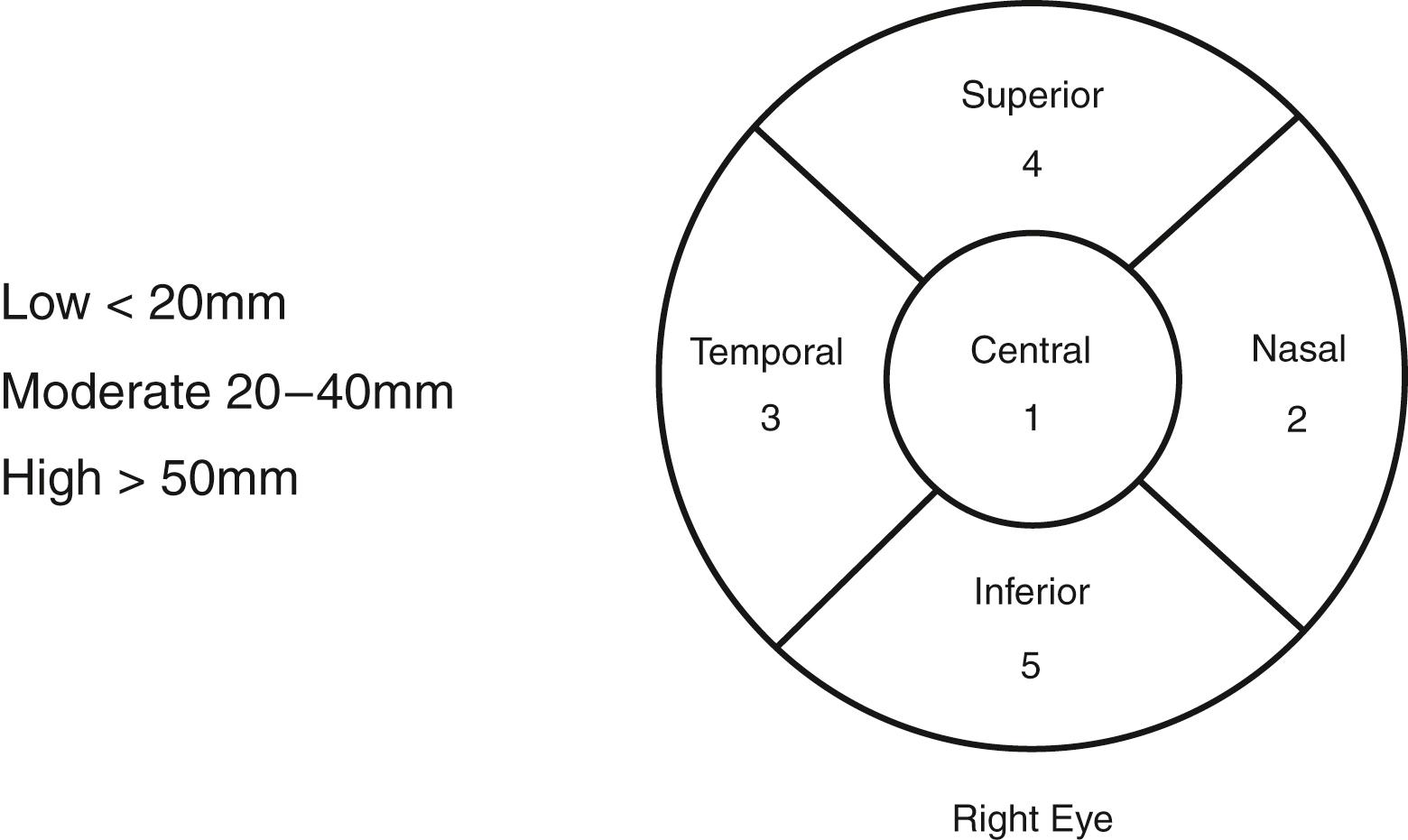
The examination of the lid includes lid snap and lid distraction tests. The amount of scleral show should be precisely measured, as any show greater than 1 mm is considered abnormal. Alternatively, the marginal reflex distance-2 (MRD-2) can be measured as the distance between the center of the pupillary light reflex and the lower eyelid margin when the eye is in primary gaze ( Fig. 56.4 ). Both the upper and lower lid can be described as having lagophthalmos. It is important to determine the contribution of each lid to complete closure separately.
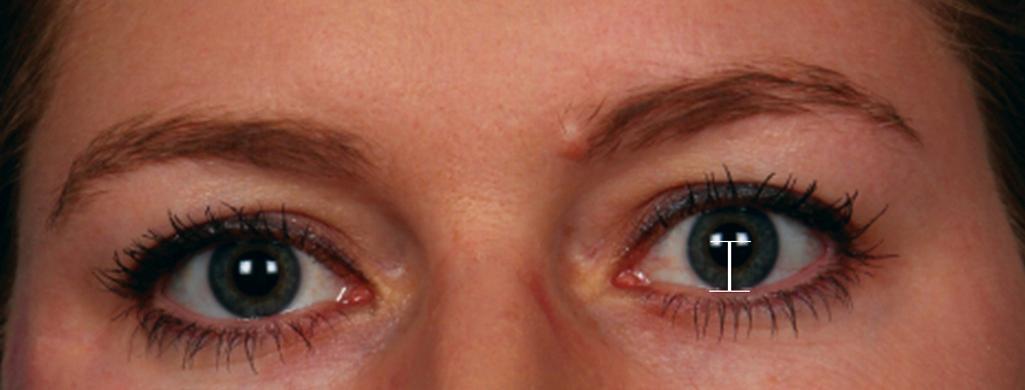
The position of the puncta should be carefully determined because the loss of orbicularis oculi tension can lead to separation of the puncta away from the sclera.
For proper evaluation of the brow position, the patient must be in the absolute repose position. A close examination may reveal that the contralateral brow may pull up out of “sympathy” for the involved eye.
The causes of FP can be congenital, infectious, idiopathic, traumatic, or neoplastic. In one large study conducted at a facial nerve center, 38% of cases of FP were due to Bell’s Palsy, followed by acoustic neuroma (10%) and head and neck cancer (7.5%). Knowledge of the etiology and its associated prognosis is important in determining whether to pursue temporary or permanent interventions. For example, most patients with Bell’s Palsy typically recover enough function to close their eye and may only need medical or reversible surgical therapy until the nerve function is regained. Alternatively, if the facial nerve has been severed completely, facial nerve repair with tension-free primary neurorrhaphy or interposition or cable graft should be performed within 72 hours, while the free nerve edges remain clean and nonretracted. , The regain of function may be seen as soon as 6 months, but it is usually not complete; more augmentative and refinement surgery may therefore be warranted. Clinical improvement may continue for up to 2 years following nerve repair. A frank discussion of the patient’s needs is also important for treatment planning purposes as well as to manage expectations.
Medical interventions are intended to replace the natural protective mechanisms that are lost with FP. The surgical options can be categorized as static or dynamic, as well as temporary versus permanent.
Early surgical intervention and consultation with an ophthalmologist may be warranted in patients who are considered at high risk for corneal damage because they exhibit a poor Bell phenomenon, have trigeminal sensory deficits, are unable to perform frequent eye care adequately, or have a significant contralateral vision deficit. It is also essential to consider the patient’s other deficits. For example, deficits in the trigeminal nerve may lead to decreased sensation in the globe and a subsequent neurotrophic ulcer. Conversely, a cornea that becomes desiccated with areas of ulceration will function as insensate because of the injury, essentially forming a neurotropic ulcer in the absence of a trigeminal deficit.
The surgical procedures for care of the eye in patients with FP are typically performed in the outpatient setting. However, in some situations, interventions may occur acutely after the injury. Interdisciplinary discussion should be conducted regarding the anticipation of immediate, early, or late recovery. If the surgical team knows of facial nerve disruption and thus anticipate a delayed or incomplete recovery, earlier intervention may be warranted. The age of the patient may also play a role in earlier intervention. The younger the patient, the more intrinsic the facial turgor, which can mimic facial tone, resulting in less soft tissue ptosis and thus improved appearance and function.
A variety of nonsurgical methods of caring for the eye can be employed immediately. Ophthalmic drops of normal saline can be administered at least every 2 hours or more frequently per patient comfort. A high-viscosity drop or petroleum-based ointment such as Lacrilube can maintain efficacy longer and can be applied to the eye before the patient intends to sleep. Patients may prefer to use ointment throughout the day for added comfort with the unfortunate disadvantage of blurred vision related to the emollient. Consideration should be given to make sure preservative free drops and ointment are used to avoid potential irritation. Bandage contact lenses and moisture chambers provide longer-lasting ways to prevent corneal desiccation. Taping the eye shut during sleep is another acceptable means of keeping the eye closed; however, this must be done with care in the corneal insensate population. Lacrimal plugging with silicone plugs has been shown to be as effective in symptomatic relief. Caution should be used with standard eye patches because this often creates an “out of sight, out of mind” mentality, resulting in decreased attention and less frequent application of drops and ointment.
Once it has been determined that the patient’s condition may require treatment beyond what is medically feasible, a careful consideration of the surgical options should be performed. It is important to note that, in general, the upper and lower face receive separate consideration regarding the functional and cosmetic procedures for the eye and the recreation of symmetry and function for the perioral area. The surgical procedures to care for the periocular area in FP can be grouped as either static or dynamic and temporary or permanent, as stated previously, and as targeting either the upper or lower eyelid. The surgical procedures to improve symmetry to the lower face are also classified as static or dynamic as well. The decision as to which intervention is most appropriate requires careful examination of the overall clinical picture, including the patient’s age, medical status, etiology of the FP, other cranial nerve defects, prior reanimation surgery, goals, and expectations.
It is most important to determine the time frame of anticipated recovery as this may influence whether the intervention is short or long term. For example, if the facial nerve paralysis is thought to endure no more than 6 months, then a reversible treatment such as an implanted upper lid weight may be indicated over a permanent procedure such as a reinnervation procedure. See Table 56.1 for a list of static and dynamic procedures.
| Static Procedures | Dynamic Procedures |
|---|---|
| Upper eyelid weight | Palpebral spring |
| Tarsal strip | Silicone rod insertion |
| Tarsorrhaphy | Regional muscle transfer |
| Blepharoplasty and brow lift | Primary neurorrhaphy |
| Lateral tarsoconjunctival flap | Cable graft |
| Canthoplasty (medial or lateral) | Nerve transpositions |
| Static sling suspension | Free-tissue transplantation |
| Lip wedge | Cable graft |
| Cheiloplasty |
It is important to note that some of the surgical ocular interventions, such as upper eyelid weights, are reversible, whereas others, such as tarsal strip, are not reversible. However, if the eyelid function returns, the lateral tarsal strip and medial canthoplasty interventions still function to improve appearance without being outwardly noticeable.
In the preoperative holding area, the patient should be evaluated in the sitting position. The patient should be marked in the upright position, particularly for brow and blepharoplasty procedures in which the procedure counteracts the downward pull of gravity, which is less evident when the patient is supine. Preoperatively, one must classify the type of smile present on the unaffected animated side. Careful attention should be given to the vector of the oral commissure excursion. The majority of the population demonstrates a gentle upturn of the corners of the mouth, also known as the “Mona Lisa” smile (67%); other smiles are the canine smile (31%) and full-mouth smile (2%). All efforts should be made to recreate a symmetric smile pattern on the impaired side; however, this is not always possible. Biofeedback and facial retraining may be necessary during the physical therapy portion of recovery. For patients receiving an implanted eyelid weight, dummy weights are used to premeasure the appropriate degree of lid load weight ( Fig. 56.5 ).
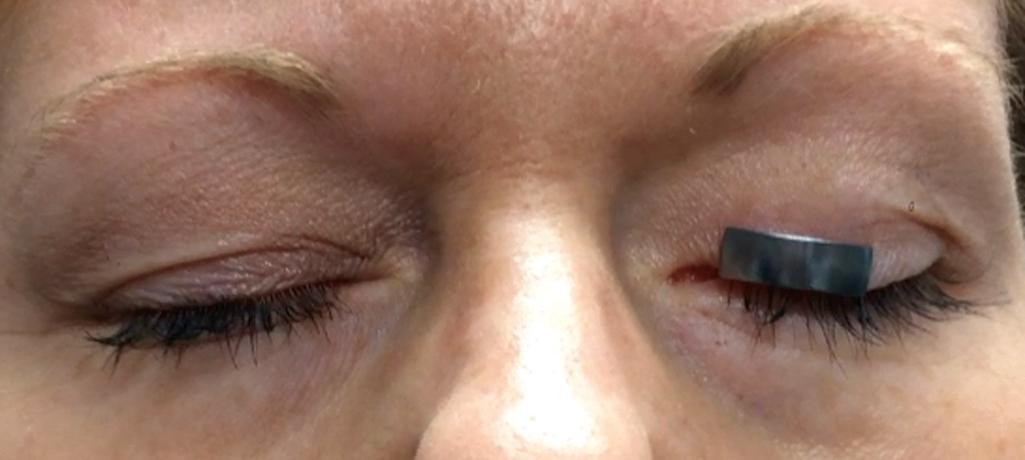
Informed consent, obtained in the clinical setting, is verified before proceeding to the operating room. The risks are unique to each procedure but generally include the need for revision or removal of short-term implants, the development of synkinesis, and the need to undergo additional procedures for further deficits if the paralysis persists and the patient develops age-related anatomical changes.
The patient is positioned supine on the operating room table. There should be adequate space for the surgeon on either side of the operating room table as well as above the patient’s head; rotation of the bed by 90 or 180 degrees may be necessary.
Injectable lidocaine 2% with epinephrine (1:100,000 concentration) may be used if the patient is to remain awake for the procedure. This solution causes more numbness with less injection, which is ideal for decreasing distortion of the tissues. It can be combined with sodium bicarbonate in a 9:1 ratio to increase patient comfort. Bupivacaine 0.5% (Marcaine) may be injected at the conclusion of the procedure for prolonged analgesia but is generally not needed. The senior author (L.H.) does not typically find these injections necessary for pain control after the procedure.
Tetracaine drops can be used in the eye to provide corneal anesthetic if the patient is awake. Ocular lubrication is also encouraged during and after the procedure to prevent corneal abrasions during the procedure.
The entire facial area should be prepared and exposed for the procedure. This is essential for creating a symmetric and proportional final result. The options for preparation agents include Betadine (povidone-iodine) solution and baby shampoo. Betadine is thought to provide better antimicrobial protection; however, it can irritate the eye if applied in standard concentrations. The dilution of Betadine to a 5% concentration with normal saline is acceptable. For patients with known ocular infections, a sterile ophthalmic 5% solution of povidone-iodine may be indicated. Corneal shields coated with ophthalmic lubricant are placed.
The entire face should be draped into the topically prepared surgical field. Although many of the procedures involve only one side, the ability to visualize the contralateral structure is essential in creating a symmetric, proportional outcome. This is especially true for canthal repositioning. A turban head wrap can be used; however, it must not be too tight as this can distort the brow position.
Additional consideration is necessary for an endoscopic brow surgery, as the intended incision sites are beyond the hairline. For procedures with hairline and hair-bearing incisions, the prepared area extends to the vertex, and an identical turban type dressing is performed tightly and then pulled back to include the proposed incisional sites and secured into position.
For patients who require oxygen supplementation beyond room air levels, the nasal cannula should be prepared into the field to avoid the tenting of flammable oxygen gas if electrocautery is required at the surgical site. For patients under deeper levels of anesthesia who require additional oxygen, some may prefer the use of a deeply inserted nasal cannula to minimize the risk of fire.
For patients undergoing procedures around the globe, ophthalmic bacitracin, erythromycin, or TobraDex antibiotic ointment can be gently applied along the suture line. A plain ophthalmic moisturizing ointment can also be used if the patient has a reaction to any of the above-mentioned antibiotics or a contraindication to the use of steroid preparations, such as glaucoma. Ice packs can be applied around the surgical sites intermittently for the first 36 hours following surgery. If the patient feels that ice improves comfort, it may be continued at the patient’s prerogative.
Chemosis, or edema of the conjunctiva, may occur, particularly following eyelid procedures. This may result in blurry vision separate from the use of emollients. Steroid-containing drops or ointments will improve these findings. The senior author finds that the side effect of chemosis will persist longer in diabetic patients and reassurance is warranted.
The main goal of upper eyelid surgery is to restore the eye closure by opposing the opening force of the levator palpebrae superioris. Ideally, the procedure is immediately effective, low-risk, and cosmetically pleasing.
The three main types of procedures are weight-loading, spring placement, and silicone rod insertion. Each has its merits, depending on the patient goals and surgeon comfort. The quality of life has been shown to improve with static treatments, although some authors prefer dynamic processes because they are better at restoring the blink reflex. ,
Upper lid-loading procedures, which typically include the implantation of a gold or platinum weight, have been the mainstay treatment for paralytic lagophthalmos. The patient is able to regain blink function, although the blink is delayed. The only medical contraindication is glaucoma. An allergy to gold should also be considered; gold allergy rates can range from 3.2% to 9.5%. , Weights are available in two materials: gold and platinum. Platinum weights are available in chain weight form as well and offer the advantage of a lower profile and decreased allergy rate as compared to gold. Chain weights are said to have the advantage of increased contour to the lid but come at an increased price.
The ideal weight is premeasured before entering the operating room. At the time of placement, the upper lid margin should be made to rest 1 mm lower than the contralateral side initially as the levator palpebrae will eventually strengthen and lift the lid. The weight can be placed at different levels, including overlying the tarsus or at the superior border of the tarsus. For patients who have persistent corneal exposure after the placement of a weight in a typical pretarsal position, a heavier weight placed deeper into a postseptal supratarsal position may be more beneficial. However, a more superior position of the weight will require a heavier weight to induce closure and could result in lid elevation or opening of the eye when the patient is lying supine. Because the function of the weight is gravity-dependent, upper lid-loading works better for patients in the supine position when they are placed more inferiorly. Particularly in patients with a negative vector or proptotic globes, a heavier weight may be required. If the weight is positioned above the apogee of the globe, such as in supratarsal or levator position, it will result in opening of the eye when the patient is recumbent.
Our surgical technique begins with an incision at the supratarsal crease with dissection directly to the anterior surface of the tarsal plate ( Fig. 56.6 ). The lash follicles may be identified at the inferior extent of the dissection, and the weight positioned directly at or 1 mm above the follicles ( Fig. 56.7 ). The weight is secured directly to the tarsus with a 6-0 Prolene (polypropylene) or 6-0 clear nylon as preferred by the senior author ( Fig. 56.8 ). The use of absorbable sutures has been described as well. Although the levator apparatus should be left mostly undisturbed, we prefer to resuspend the soft tissue in the distal levator area with a buried 5-0 or 6-0 Vicryl (polyglactin 910) stitch, despite the fact that this is not universally employed by all surgeons. Care should be taken to ensure that this resuspension stitch does not alter the eyelid position in any way ( Fig. 56.9 ). The skin may be closed with 6-0 fast absorbing gut or 6-0 nylon suture in a simple running fashion.
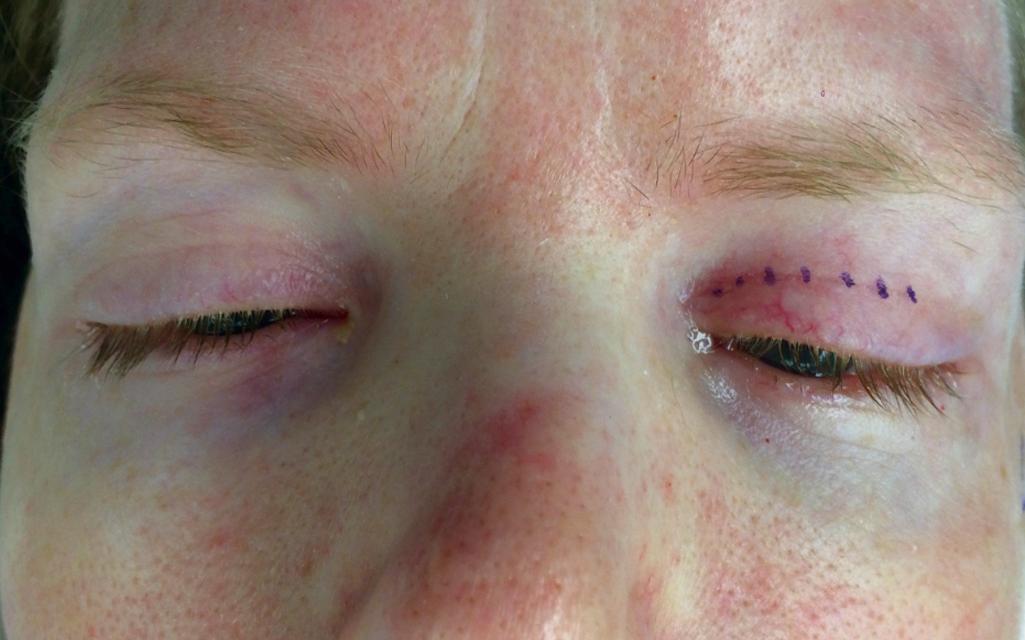
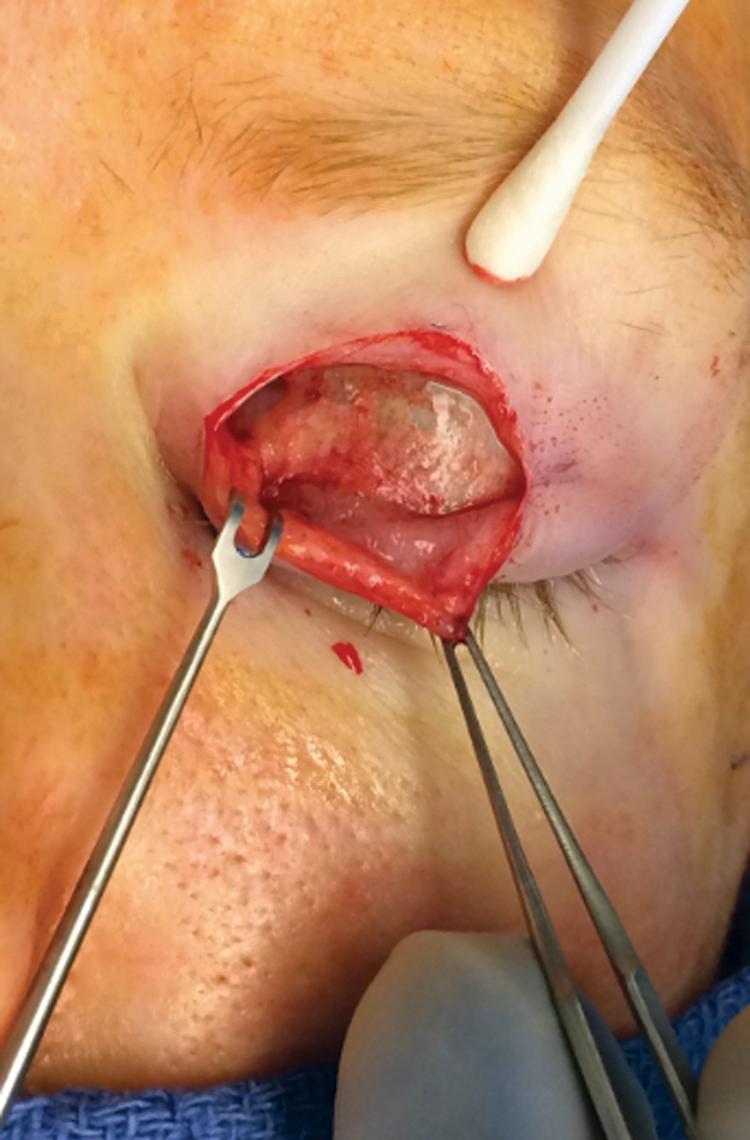

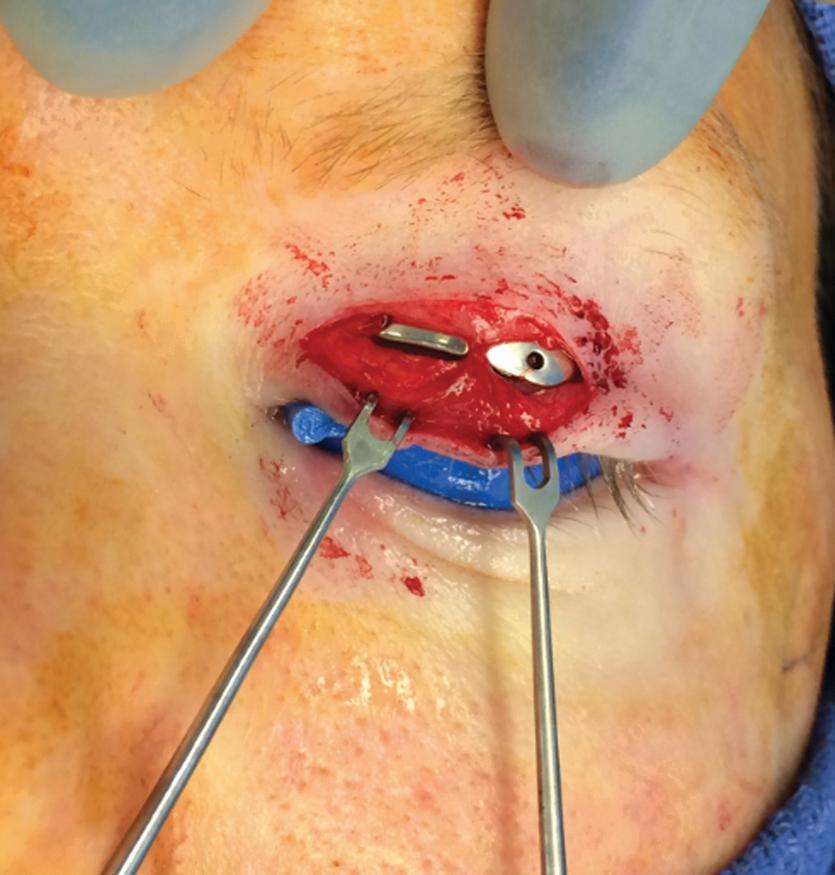
The complications of gold weights include infection, implant migration and/or extrusion, visibility or prominence of the implant, astigmatism, and inflammation. These complications have led to increased interest in platinum implants. Platinum has the benefit of being denser than gold (11%); thus, a physically smaller implant is needed for the identical actual weight in gold. Platinum is also felt to be less reactive and can be made into flexible chain linkage to improve the contour along the tarsus. , Platinum weights have also been shown to cause less reactive capsule formation. For both implants, lower profiles have been developed to decrease the rates of implant extrusion. For patients with mild, temporary paralysis who are very poor surgical candidates, an injection of hyaluronic acid gel into the upper eyelid can be an effective lid-loading strategy.
If patients are fortunate enough to regain most or all of their facial nerve function, some static interventions can be reversed by removal of the implant. In determining if the removal of a gold or platinum eyelid implant is indicated, one can test the patient’s ability to close the eye by closely observing the closure while the patient is lying supine with the head hanging. If the supine patient can close the eye against the contra forces of gravity, then the implant is no longer necessary and may be removed.
Labbé has described a modern version that uses Tessier’s technique of lengthening the levator of the upper eyelid by grafting an aponeurosis to weaken it while the gold weight reinforces the closing ability. The aponeurosis is harvested from the temporalis muscle via a coronal or temporal incision and is trimmed to approximately 2 cm.
Palpebral springs, which are considered a dynamic reanimation technique, are not gravity-dependent and can result in a fast blink. They may be especially helpful in patients who demonstrate a poor Bell phenomenon. Springs have been shown to be effective with a low complication rate in experienced hands. Despite a dynamic advantage, they demand exact placement, may extrude or suffer from metal fatigue, and may require revision as do other techniques.
The best-known technique has been described by Levine. Building the spring from a plain piece of wire may be done in the office or at the bedside, and is a time-consuming process. Wires are usually 0.011 inches (0.28 mm) in diameter, but 0.009 inch (0.23 mm) may be better in patients with weaker levator muscles. An 8-mm loop is made, which will become the fulcrum of the spring. The wire is placed in the lateral orbital rim, and curves are made according to the patient’s eyelid anatomy. The wire is then sterilized before use in the operating room.
Become a Clinical Tree membership for Full access and enjoy Unlimited articles
If you are a member. Log in here